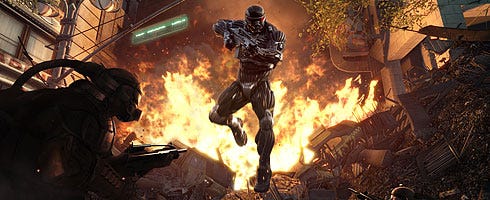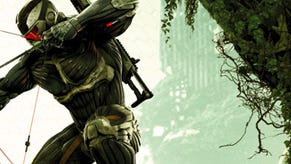Interview: Crytek CEO Cevat Yerli on Crysis 2 (part 1)
We saw Crytek president Cevat Yerli lead Crysis 2's reveal in New York this week, and were the first to speak to him after the developer had aired 360 gameplay for the first time. Hit the link for an excited CEO shouting in a packed room.
You’ll find eyes-on gameplay impressions here, and the first major trailer and images here.
How do you think that went overall?
Cevat Yerli: The event went well. I’m very happy with it. The game looked good. It’s a sandbox game, you know, and a sandbox demo is quite a challenging one as it can look as bad as the person playing it [laughs], and it can look as good as the person playing it. But Nathan played good, and it looked good. So I’m happy.
Were you nervous about showing the game on 360?
Cevat Yerli: Yeah. The 360’s a console platform, so it’s always a challenge, right? We said, “We have to make it right.” We can’t just make a PC demo then say we’re giving a console demo. I don’t know if you saw, but there was no second 360. We said we were going to risk it, you know; push it to the limits. It’s still work in progress technology and code, so yeah: I’m very happy that it went well.
You’ve already said in public that you had a few issues in scaling back your tech to fit on consoles?
Cevat Yerli: It’s not about scaling back, it’s more about making gameplay that’s unique to consoles and PCs at the same time without looking like it’s scaled back. The entire experience has to be top notch. The urban jungle, the verticality, makes a more attractive experience overall; all these things play into a role of making a better experience overall. Verticality, interaction and high fidelity graphics are all possible on 360, so we said we could push out those boundaries and create a lush experience versus the PC version. I really don’t feel we’re compromising something.
What framerate are you going for on console?
Cevat Yerli: It’s 30 frames a second, right? We’re looking at 30. There’s nothing below, nothing… Today was [inaudible]. We’re still work in progress. I’m very happy the game works at all [laughs]. I think the amount of push we have and the fact the game works like that puts me in a very happy situation right now.
Quite frankly is looking f**king amazing. Very impressive. How far have you got to go in terms of world-building and tech? Are you reasonably complete?
Cevat Yerli: Yeah, yeah, yeah. The part one production problem is tools, and we’re finished. It’s really about putting the world together now. This stage is in a finished state, not the entire game. That’s the way development is. We push one step and we have to bring up all the other areas to the same quality which can be challenging. But we’re a company that never compromises in quality, so this will be our battle for the next couple of months.
The destructibility plays a huge part in what was going on there.
Cevat Yerli: Exactly.
Do you think that the first-person genre in general is a little tired? Do you think that by adding destructibility and player empowerment you’re bringing something completely new to the genre?
Cevat Yerli: Destructibility is not just a matter of “feature”. It’s not just a case of, “OK, let’s make the world destructible.” Destructibility has to be the means to an experience; I want the game to feel dynamic, to feel reactive to any action I do; I want to feel the game change based on my combat; I want the world to adapt and I want to be able to look back and see what I just did; I want to leave a landmark of an experience. Destructibility to me goes through many parses, through many dimensions; it’s not just a matter of head reactions. The technical hurdle, of course, makes this difficult to achieve, but we’ve been pushing this since Crysis 1, and we’ve been pushing this now with Crysis 2 and we have different problems as we have a different location, but the same goals, really.
How’s it been working with an established sci-fi author like this? Has it been a pleasant experience?
Cevat Yerli: It’s like this [knocks fists together]. It’s like, “Richard, why don’t we do this?” “No, we cannot!” “Richard, it’s a game!” I’ve learned a lot in this process, and he learned a lot as a well. We are “fusioning together” – I hate to use the word “synergy” – we are fusioning both writing and creative direction together, really, to make this experience. This is a unique kind of space. First-person games don’t really push story, you know? We’re really pushing on that to see how far a guy like him and a guy like me can push the boundaries together.
And how far can you push them, Cevat?
Cevat Yerli: You’ll see man, you’ll see. I think you’ll like it. I like it.
On the story theme, how dark and adult are you going to go? Richard was talking about noir elements in the conference. Are we going to be shocked at all?
Cevat Yerli: I think it’s going to be dark and bright at the same time, to be honest. There’ll be dark moments but there’ll also be bright moments. I think the whole time will be up and down, up and down, and you’ll be thinking about what’s going to happen next, about what’s driving you. For me one of the most important things about game direction is that my motive and the story’s motive are the same. So, as a player, if I want to kick alien ass in an environment but the story wants me to continue then [inaudible]. I must feel that for every objective and for every moment, story and my own motives are in line. That is a challenge, because very often – and this is the same in movies – they want the user to feel something but the player feels something completely different. One of the best of all moments in movies was in Saving Private Ryan.
Right.
Cevat Yerli: Where in the first 20 minutes or so…
Everyone dies.
Cevat Yerli: Yeah. And that’s in perfect alignment: the user’s motivation and the story’s motivation, where you just felt like it. You wanted to know what’s next. The challenge in game design is that the developer draws up the objective and the story just tacks on. Or the gameplay is better than the story. In Crysis 1 we had a situation where the gameplay was so fun that they died, rebooted, died, rebooted, and they forgot why they were doing it because they didn’t want to continue. It was because the story wasn’t at the same level. I said to Richard that his job was to outpace me.
You were very committed to the PC platform with Crysis 1…
Cevat Yerli: I’m committed to gamers. PC, console, it doesn’t matter what it is.
Why are you bringing it to consoles, specifically?
Cevat Yerli: There are more gamers.
Is it to do with sales, or…
Cevat Yerli: No, no. My nephew, my family. Sometimes I play games [on consoles] with my wife, even, and it’s like, “It’s a shame Crysis isn’t there.” And I’m like, “I know, I know.” Consoles have more penetration of gamers and there are more players playing games. Sometimes it’s harder to target them. This whole analogy of Dumb and Dumber isn’t true. They are actually more brutal in their judgement, rejecting an average game, while a PC gamer gives it more time, you know what I mean? It’s like “top or flop” holds faster with the mainstream, right? Can we be the top game or not? On PC the platform is more forgiving sometimes. For me it was a challenge. But it’s not about sales. It’s never, ever about sales. Sales is EA’s job.
Last one. Is Crysis 2 going to be the next game PC gamers use to benchmark their hardware?
Cevat Yerli: I’m confident we’ll push the boundaries of PC gaming, as we ever did.
The most expensive hardware out there? You’ll take it right over the top?
Cevat Yerli: That I wouldn’t bet on. But what I will bet on it that we’ll have the best PC experience possible. From a Crytek perspective we’ll do whatever it takes to make the best PC experience.
The above is taken from grabbing Cevat straight after the game demo. Check back after the weekend for another interview we did with him the following day. Crysis 2 ships for PC, PS3 and 360 this "holiday".










